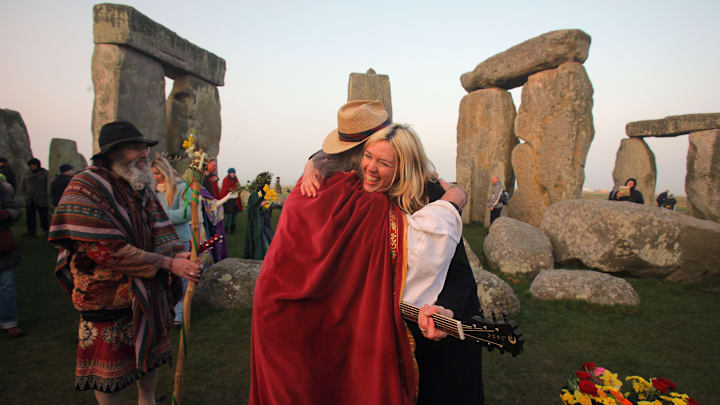Twice a year, the sun sits vertically above the equator, giving us nearly equal day and night everywhere on the planet. This year, March 19 is the vernal equinox in the Northern Hemisphere. Here are nine spring equinox rituals people partake in to celebrate with the (roughly) 12 hours of daylight.
1. Stand an Egg on End
Eggs are often associated with the spring equinox because of their standing as a symbol of birth and fertility. The myth that one can be balanced on its end only on that day likely relates to the day’s re-balance of day and night. But don’t worry: If you’re too busy to experiment with egg balancing on the day of the equinox, you can certainly try it the following day. It takes practice, but eggs can be balanced any day of the year.
2. Honor Dionysus With a Bread Phallus

Dionysus—the god of fertility, wine, flowering plants, poetry, and theater—is often associated with phalluses (for fertility) and bread (because of ritual meals involving the consumption of bread and wine). To celebrate the coming of spring, modern pagans offer up tables of wine, flowers, and phallic symbols made of food.
3. Celebrate the New Year

Countries like Iran, India, and Turkey, among many other areas of Asia, observe the New Year on the spring equinox, generally in observance of Nowruz (which means “new day” in Persian). Specific religions also adhere to the holy day, including the Bahá’í Faith.
4. Take a Trip to Mexico
That’s where you’ll find Chichén Itzá (one of the New 7 Wonders of the World) and the ancient Mayan pyramid, El Castillo, where the Return of the Sun Serpent puts on a shadowy show every equinox.
5. Have a Family Reunion
Called Shunbun no hi, Japanese people spend the week of the vernal equinox visiting their hometowns, spending time with family, and tending to ancestral graves.
6. Plant Seeds

Many pagans celebrate the spring equinox by planting seeds. March is a great time to get ahead on your gardening goals. You can plant carrots, lettuce, onions, and potatoes outdoors, and start summer plants like peppers and tomatoes indoors. For the summer plants, you’ll relocate them outside once the weather is more appropriate.
Read More About Seasons Here:
7. Give Your Mother Some Love

Many Middle Eastern countries like Egypt, Iraq, Saudi Arabia, and Syria celebrate Mother’s Day on or around the same day as the equinox. But even if you live elsewhere, we’re sure your mom would appreciate a call.
8. Visit a Megalithic Monument

You know, like Stonehenge. On the summer and winter solstices and spring and autumn equinoxes, Stonehenge is open to visitors (and the local Druids) who want to witness the sunrise over the stones.
9. Finally Understand Why the Easter Bunny Lays Eggs

This comes from an ancient Saxon tale about their lunar (or spring/summer) goddess, Eostre. One story generally goes that Eostre found an injured bird and transformed it into a hare to save its life; the transformation was incomplete, and in gratitude for saving her, the hare laid eggs and decorated them as gifts to Eostre (or, alternately, the hare found an egg and decorated it for the goddess). More likely, it was that rabbits and eggs were both seen as symbols of fertility, and Eostre was the goddess representing spring and fertility. Parts of the myth were eventually absorbed into the more modern Easter celebrations, as both festivals occurred around the same time.
A version of this story originally ran in 2009; it has been updated for 2024.
